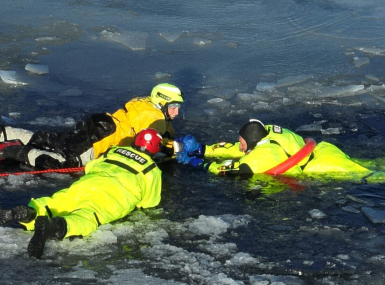Local sand trap makes good

Ten years ago, while pre-teen Jordan Spieth spent hours chipping and putting his way toward this year’s U.S. Open, Pierce County, Wash. was laying the foundation for the course where he would claim that championship.
They had the same ambitions — greatness.
When the county started building its third golf course, on a former rock and sand quarry, the goal was nothing less than to someday be home to the biggest golf tournament in the world. And less than seven months after then-County Executive John Landenburg drove the ball off the first tee in 2007, the United States Golf Association (USGA) awarded the 2015 Open to Chambers Bay. Back then no course younger than 10 years had ever received that honor. It was also the first county-owned golf course to hold the prestigious tournament.
Preliminary estimates say the county saw between $140 million and $150 million in economic impact — with $8 million in projected tax revenue — and the county itself will get a 10 percent cut of merchandise sales. That’s against the $20 million for course design and construction.
“It was a spectacular success,” said County Executive Pat McCarthy. “We know anecdotally that it was phenomenal for the region, and when a number of formal studies come out, we’ll have a better idea what it all meant economically. But this put Pierce County, the state of Washington and the Pacific Northwest on the map. We knocked it out of the park.”
She’s not a golfer, but McCarthy was able to keep the course operating when the recession led to drops in the course’s revenue from greens fees.
“The course was really struggling,” she said. “A higher-end golf course was the kind of thing people cut out when the economy was bad.”
Once she transferred course management to the parks department from public works, the additional programming led to increased revenue.
“We’re in the programming business; it’s a natural fit,” said Parks Director Tony Tipton. “The community understands that and embraces the active recreation and the passive recreation — you can play a championship course or walk the trails and see the Puget Sound.”
Off the Tee
The course’s urban setting along the Puget Sound helped fuel the county’s dream.
Early on in his tenure as county executive, Landenburg saw potential in the quarry, which was purchased for $33 million in 1992 as a buffer for a sewage treatment plant. “I looked at the land, and knew we had to open up this property on the Puget Sound to our residents,” he said. “The best thing here would be a park.”
But parks aren’t revenue neutral.
“Golf courses pay their own way,” he said. “Everything else is subsidized.”
Pierce County already had two golf courses, with even more public courses nearby, too. What would set the quarry apart was a championship-caliber course, bringing professional golf into Washington state.“
As an industry, it didn’t exist in our state,” Landenburg said. “We had our goal — holding the U.S. Open, and we knew the biggest mistake we could make was not setting our sights high enough. If we can get the biggest tournament in the world, we’ll be able to get a lot of other events.”
What the quarry offered was a course designer’s dream. Only one tree, no lakes, sand everywhere for a completely malleable surface.“
Every hole could be shaped the way we wanted it,” Landen-burg said. “We had 56 architects apply.”
Pierce County chose Robert Trent Jones Jr. as the architect.
Hand-in-hand with the technical aspects of the course came the ancillary considerations for holding a tournament — the infrastructure to handle visitors, support staff, vendors, corporate tents. The 2015 tournament involved more than 300 temporary structures and the course was designed to accommodate them.
Course design considered the views cameras would capture at certain times of the day on the third Sunday of June, historically the date of the U.S. Open final round.
The construction began in 2005, finished in 2006, and after letting the course settle, play began June 23, 2007.
Throughout the process, Landenburg lobbied the USGA to check out the course, knowing the organization had an interest in holding an event in the Pacific Northwest. “We brought the whole pack-age to them, that we had room for the corporate village that goes along with a major tournament, that we had so many hotel rooms within 60 miles; we gift wrapped it for them.”
Along the Fairway
The course is built in the British links style, with wide fairways and solid ground. The Pacific North-west climate is similar to that in the United Kingdom.
“The ball rolls a lot,” said Tipton, the county parks director. “It’s a different feel than a lot of people are used to.”
There are also no cart paths. Carts are only available for golfers with medical conditions.
At 250 acres, the Par 72 course is roughly twice the size of many others. And it has wide appeal.
“It’s good for a 15 – 20 handicapper or a scratch golfer who wants a challenge,” Tipton said. “Five sets of tees gives you that flexibility.”
The greens fees can approach $300 at their highest, though Pierce County residents get a discount.
The Fescue turf that covers the course, which needs considerably less water and fertilizer than other golf course grasses, contributed to Chambers Bay being named the second most environmentally sustainable U.S. course out of more than 14,000.
On the Green
“The USGA took a risk in having the Open here,” McCarthy said. “It was attractive to have the tournament in the Pacific Northwest, which it hadn’t done before, but there were a lot of open questions.”
But Pierce County, Kemper Sports (which manages the course) and the USGA answered all of them. The USGA leased the course, managed the entire event and helped cover costs.
Playing host to the U.S. Amateur tournament in 2010 gave the USGA, and the county, a practice run holding a serious event on the course.
“We learned a lot about transportation issues made modifications on four holes, all of it covered by USGA,” McCarthy said.
The county put in $1 million for public safety, most of which went for traffic control. Local cities contributed $340,000. The Pierce County Sheriff ’s Office was the lead agency for public safety.
In the end, the event was a success, the Open sold 36,000 daily tickets — Landenburg said the course could probably accommodate 50,000 — and in addition to the projected $8 million in local tax revenue and the cut of merchandise, Pierce County got the sporting world’s attention on national television.
And the confidence to go for another U.S. Open in the future
Attachments
Related News

HHS releases rule repealing federal nursing home staffing mandate, supporting county long term care facilities
On December 2, the U.S. Department of Health and Human Services (HHS) published an interim final rule that repeals the federal nursing home staffing mandate, a regulation that would have required long-term care facilities to meet strict minimum staffing levels.
Stretching small opioid settlement allocations helps funding do more
States and localities are set to receive $56 billion in opioid settlement dollars over an 18-year period, but not every county that receives settlement funding will get enough to build out infrastructure.

County officials moonlight in search and rescue roles
For some county officials, participating in search and rescue operations is another way to serve their communities, and make it safer for people to enjoy natural creation resources.
